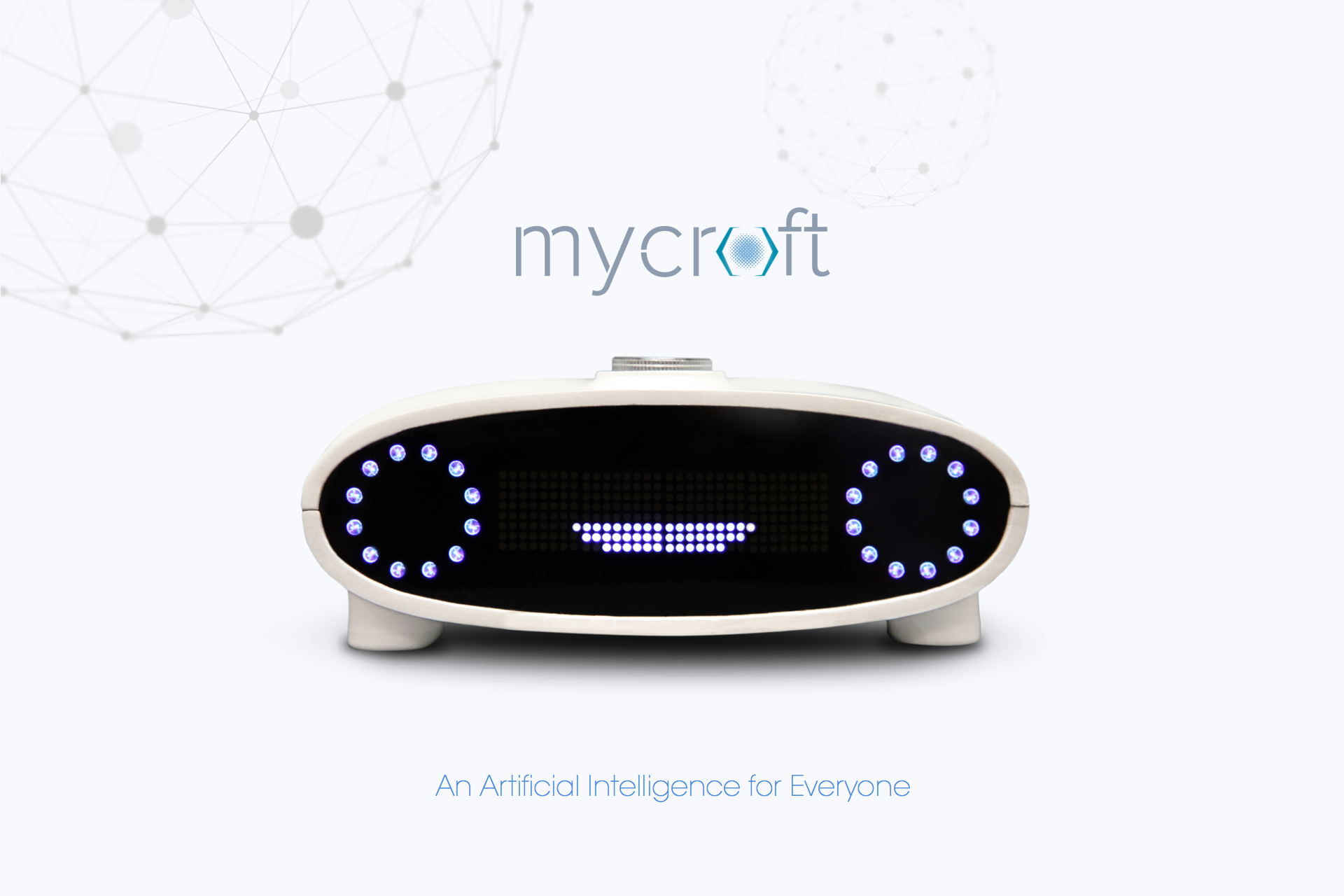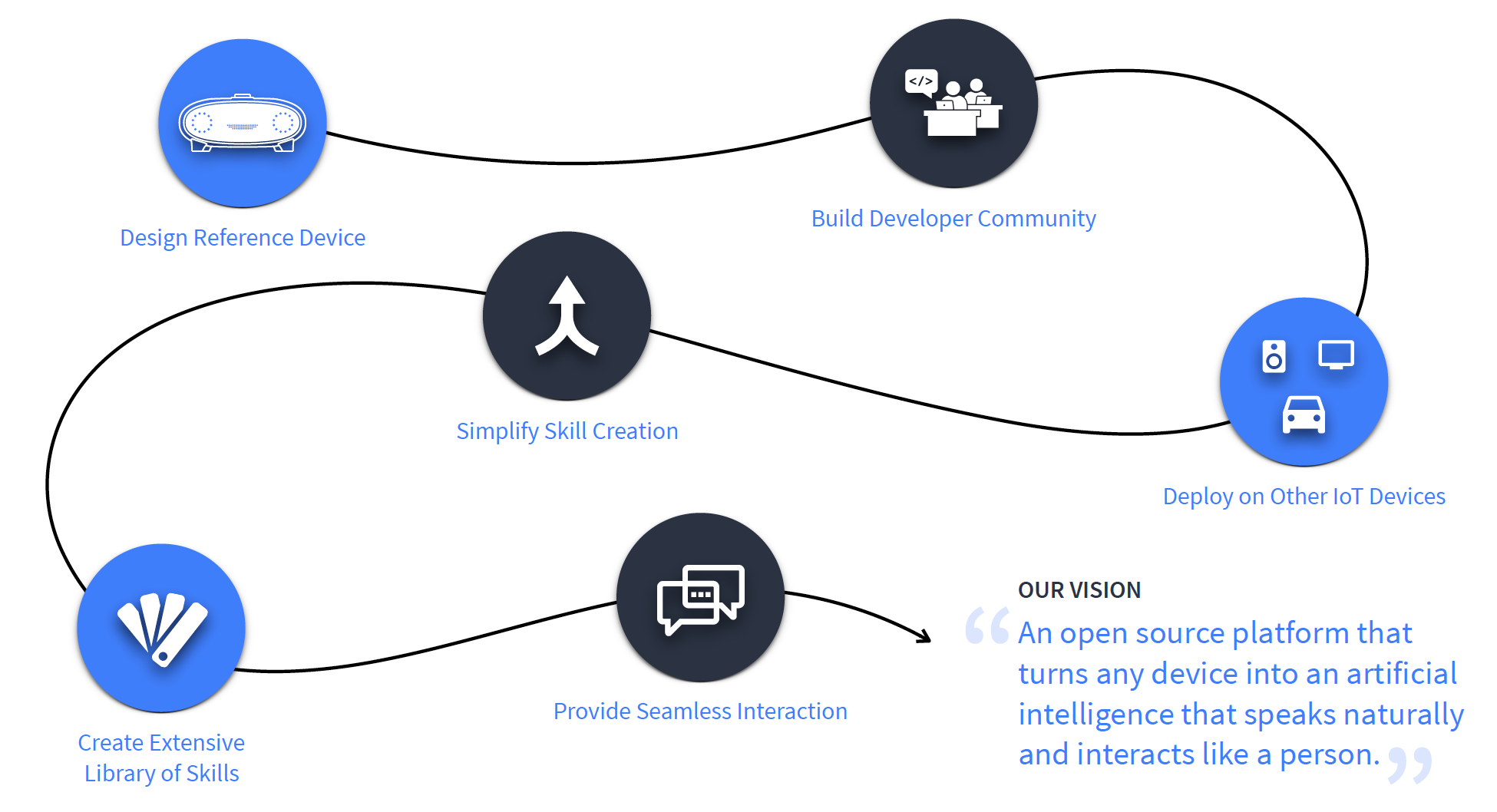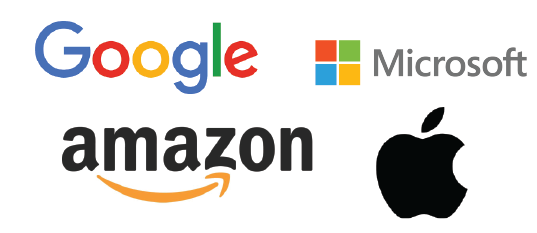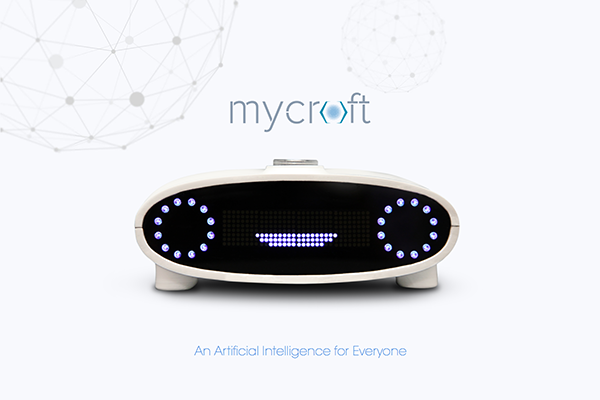Mycroft Aims to Beat Amazon and Google to Become the Voice Leader
 Mycroft is different. It isn’t a Silicon Valley giant. But, it is competing directly against the biggest tech companies: Google, Amazon, Apple, Microsoft. Mycroft doesn’t protect its innovations like these more established players do with their proprietary code bases and development stacks. Instead, Mycroft opts to share its technology with everyone through an open source license. The company didn’t start with a big slug of venture capital investment. It funded early development through a Kickstarter campaign. Mycroft didn’t originate in a Stanford dorm room, but does have a University connection. It started in a maker space adjacent to the University of Kansas before going on to Tech Stars and a new Bay Area location. Voicebot connected with Mycroft CEO, Joshua Montgomery, to learn more about the growing company with big ambitions.
Mycroft is different. It isn’t a Silicon Valley giant. But, it is competing directly against the biggest tech companies: Google, Amazon, Apple, Microsoft. Mycroft doesn’t protect its innovations like these more established players do with their proprietary code bases and development stacks. Instead, Mycroft opts to share its technology with everyone through an open source license. The company didn’t start with a big slug of venture capital investment. It funded early development through a Kickstarter campaign. Mycroft didn’t originate in a Stanford dorm room, but does have a University connection. It started in a maker space adjacent to the University of Kansas before going on to Tech Stars and a new Bay Area location. Voicebot connected with Mycroft CEO, Joshua Montgomery, to learn more about the growing company with big ambitions.
What is the origin story behind Mycroft?
Joshua Montgomery: For us it was a personal use project. We have a maker space adjacent to the University of Kansas. We don’t have one of those famous addresses so we wanted to do something innovative such as put the Jarvis computer from Iron Man in our space.
At the time, the Echo wasn’t out yet and Siri was still locked behind a wall at Apple. We wanted one that was open that could do whatever we wanted to with it. So we wanted to build our own. Then we decided we wanted to fund it through Kickstarter and we saw that there had to be a hardware component.
We then decided we wanted to take the best robots from Scify that were cute and could convey an emotional context to humans. We built it in conjunction with Derick Schweppe, a Design Instructor at University of Kansas, and we killed it. He helped us capture what we wanted in the device.
What was your original objective?
 Montgomery: We just wanted to build Jarvis from Ironman. Jarvis requires hardware. You need a speaker and microphone. We needed to built a package so we took it to Kickstarter to see if there was a market for this. There was. We hit the nail on the head with that. Amazon also hit the nail on the head with it, but we started much later than Amazon.
Montgomery: We just wanted to build Jarvis from Ironman. Jarvis requires hardware. You need a speaker and microphone. We needed to built a package so we took it to Kickstarter to see if there was a market for this. There was. We hit the nail on the head with that. Amazon also hit the nail on the head with it, but we started much later than Amazon.
We also wanted something that our developer community could grab onto and build things that inspired them. We wanted to build it in an open way. We realized that the human-computer interface is about to make a profound shift that will impact how everyone works with computer systems. You point and grunt. That is the graphical user interface for humans. It is the most basic type of communication. The GUI is the same paradigm that we have been stuck with for almost 30 years. We are now entering an era where computers understand human language the same way we do. That is going to be a sea of change.
As we were building this we realized that we were building more than a toy for our maker space. We are in a position to democratize the voice interface space the same way that WordPress democratized the CMS space; the same way that Android democratized mobile OS; the same way that mySQL democratized relational databases. If these open source innovations didn’t exist it would have stunted the growth of those technology sectors. If everything needs to be licensed, it is a barrier.
In the voice space it is us. There is no one else out there doing this. You can look at the voice industry today the same way you looked at the mobile market in 2007-08. There were giants of industry: Nokia, Blackberry, Microsoft, Apple. Along came this open solution Android that was later acquired by Google, and is now more than 80% of the market. It led to tremendous innovation.
That is really where the voice space is today. You have these pillars of industry that appear unassailable — Amazon, Microsoft, Apple — and you think they are the future. In the voice space it is very important to have an open alternative.
 What is your goal for Mycroft?
What is your goal for Mycroft?
Montgomery: To become the global leader in open access voice interfaces. When someone wants to deploy a voice interface on a new product, a product or STEM project, or anything else, we want them to have a complete voice interface that they can access and customize however they choose. They can access this as software only. We are working with auto manufacturers, app maker, retailers and speaker manufactures today. There are a lot of people that want to deploy voice technology.
We have open hardware and open software available to everyone and we encourage them to build on it and improve it. We are not really a hardware manufacturer.
What is the status of the Mycroft Kickstarter project?
Montgomery: Fifteen hundred units running now [in manufacturing]. We will have assembly in-house and then those will ship in the spring. Depending on how quickly that goes, we may stay in the hardware market or exit and allow others to build that part of the stack.
How do you intend to generate revenue?
Montgomery: The idea for us is to make it easy to combine all of the APIs that make this work. To provide users with a good experience for search or weather information, we have to go directly to the source of that information. If people want to negotiate an API key with all of these vendors [directly] they can do that. Alternatively, they can sign up for an account with us and immediately have access to all of our API keys. People that want to have premium voices, they can pay us $2/month. We are working with Unbuntu for 40 million devices and another [company] for a million devices. We have the opportunity this year to be on 100 million devices.
For enterprises, we offer all of the same capabilities from Siri or Alexa that they can deploy inside their own products or enterprise. If your employees have Android devices to manage inventory or personnel records, we can put voice wrappers around that and make it available inside their enterprise. Eventually our premium services will include music and video subscriptions as well.
 This is a market dominated by tech giants today. How will you compete?
This is a market dominated by tech giants today. How will you compete?
Montgomery: I would point to the smart phone market. What is the name of the company that makes a Blackberry? Where is RIM today? Open standards have a real opportunity to end up dominating their markets. Siloed industry technologies have their limitations.
It is far too important a technology to leave to the proprietary ownership of Silicon Valley giants. Siri, Alexa, Assistant, Cortana are fantastic products. We are building something that is comparable or better, but this market is too big for one company to dominate. There is plenty of opportunity for an open alternative.
Data sets for training are said to be one of the big advantages for players like Google and Amazon. Where are you getting your data set to train the system?
Montgomery: We do have data access through a substantial training set from our partners. We will be working with other open source partners to build a larger data set — not to keep it private, but anonymize it and make it available to the general public. One of our goals is to make a big data set public so we can improve the underlying technologies through the open source community.
Viv was acquired by Samsung earlier this year. How does Mycroft compare to Viv?
Montgomery: We are open. We have all of the same skills here including people who came from the Siri and Echo teams. The differentiator is that we are an open platform. Being open makes all the difference.
When I used the G1, which was one of the first phones to have the Android OS on it, the experience at the time was not nearly as good as other services. But it improved and now Android has 88% of the market. The voice space is the same way. Today we cannot provide an experience like Alexa, but by working with teams, we will eventually be able to put something else out that is comparable and eventually superior.
How are you funding the business?
Montgomery: We raised an Angel round in September and are close to [finalizing] a seed round in the first two months of next year.









